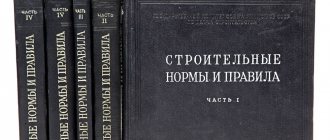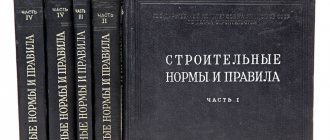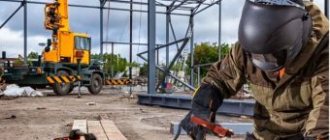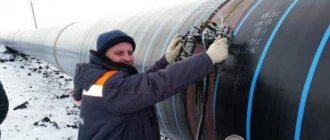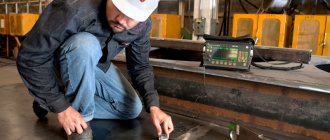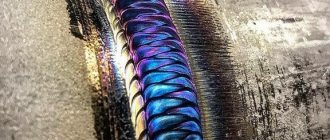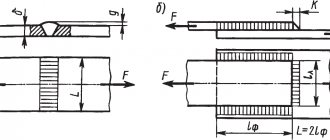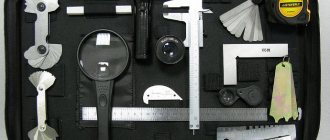Home / Welding technique
Back
Reading time: 7 min
0
502
In production, it is necessary to follow instructions and observe safety precautions; only this will ensure quality control and speed of work.
In different countries, for example Russia, such rules are spelled out in special documents - construction, state standards, and other regulatory documents. Anyone who has ever applied for a job understands what we are talking about.
At the beginning of their careers, welders often do not pay enough attention to these rules and regulations, which is quite predictable. Who will enjoy a lot of papers written strictly according to form, which you can spend more than one day reading?
But this moment cannot be missed, so we have simplified and compiled our list based on GOST standards, which should not be underestimated.
Here you will learn how to calculate time, daily workload, how to check your work and what requirements are imposed on it. This is true for both construction and welding.
It is now easy to carry out control yourself, and dozens of sheets in an official business style will not take up time and nerves.
- Welding standards
- Time standards
- Production rate
- Electricity consumption standards
- Component consumption rate
- Time calculation Calculation algorithm
- Requirements for the mechanical properties of a welded joint
Welding standards
If at any point all this seems useless to you, we will make it clear why you should pay attention to it.
In addition to theoretical knowledge and practical skills, which are important, working in production requires rules, SNiP and quality control of welds, which will regulate the speed of task completion, set standards and test the level of professionalism of workers.
The salary level will also depend on this. Without this, all work will turn into chaos, and in production, order is absolutely necessary.
Now all these rules control the time required for a fixed amount of work, the amount of resources that the master will need to complete the work. Now we will talk in detail about each of them.
Time standards
In many post-Soviet countries there is a clearly established amount of time for welding one meter of material. They are in regulations, SNiPs and quality control of welds.
But even if you read them, everyone needs to be able to calculate the time they need, because this is how your work is mainly assessed.
The entire welding process is divided into stages, and a certain fixed amount of time is allocated for each of them. Welding consists of preliminary preparation and welding itself, or more precisely:
- The main stage of production, which consists of preparing the metal, processing and of course the welding of the material itself.
- An additional stage is to check the result of the work and move this design to the next stage of production.
- Free time that is allocated to the welder to process the part between the previous two stages of work, with the ability to postpone the part for a while if necessary.
The accuracy of the calculations must be high enough; every second of extra time must be taken into account.
An example would be the stages of preparing equipment, igniting the machine before starting welding, replacing parts and cleaning the welding site, and similar processes.
Of course, we must not forget about rest for the master, which is approximately 20% of the time, cleaning and preparing the workplace.
In addition to all these details, the calculations use the welder’s individual coefficient, which is determined by his productivity and experience.
Each employee has an individual number that is entered into the calculations. This is your productivity quotient.
This can be calculated in different ways, but a popular and simple method is to assign a unit of work. One conventional unit is one completely completed task. The higher your qualifications and experience, the higher this number accordingly.
But with a larger number of tasks, this method will be inconvenient, then the calculation is made based on the time required for one meter of welding.
It may seem to you that the calculations are difficult to make, but this is not at all true. We will be able to prove this after we discuss the remaining standards and SNiPs for quality control of welds.
Requirements and types of quality of welded joints
When welding seams, the metal used must meet a number of requirements. Here are the main ones:
- the value of the relative elongation of the material is from 16% and above;
- impact strength of the metal is above 24 J/cm2, this value is measured at the average daily air temperature in the coldest five-day period;
- the ability of the metal of welded joints and seams of metal structures to have temporary tensile strength must be the same (or higher) as that of the main metal from which the welded products are made;
- when welding metal products at a factory, it is important that the hardness coefficient of the metal of the seam joint is up to 350 HV for metal structures of the 1st group and less than 400 HV for products of other groups described in SNiP II-23-81;
- when welding during installation and assembly of structures, the hardness coefficient of the weld metal should not be higher than 400 HV.
Following the necessary rules and monitoring the welds of metal structures will help maintain the integrity and safety of welded joints, avoid early loss of strength and emergency destruction of metal products.
According to the quality, seam joints are divided into three categories:
The first category includes seam joints that have the highest performance characteristics (strength, durability, tear resistance, etc.). These include the following types of seams:
- transverse butt joints subject to strong tensile stresses;
- lap, tee and fillet weld joints that operate under tensile stresses;
- seams in metal products classified according to SNiP II-23-81 to the 1st group (or to the 2nd group, if the air temperature where the metal structure is erected falls below -45 ° C).
The second category includes seams of average quality. These include:
- longitudinal joint elements subject to shear stress;
- connecting fillet welds in metal products of the 2nd and 3rd groups, which are subject to tensile stresses;
- seams in corners and joints connecting gussets with compressed elements of metal products.
The third category includes low quality seams, including:
- transverse seams in joints subject to compressive stresses;
- longitudinal connections at joints, as well as connecting seams at corners, which are used in compressed parts of structures;
- connections at joints and corners used in auxiliary parts of metal products.
Production rate
This rate is determined by the amount of work you have done over a fixed period of time. As you already understood, this could be the time per meter of welding, or the number of products for the entire working day.
In some documents this is an independent rule, but it can also be an integral part of other rules.
Before you get completely confused, let's look at everything we described using a simple example. Let's imagine that a person needs to do 48 meters of welding work in one day.
We make the necessary calculations, namely the time for preparation, rest, the work itself, cleaning the material and other processes.
The result is that the average worker will have to complete 6 meters in an hour. Thus, in eight hours of work you will have time to complete the set amount of work.
CATEGORIES OF WELDED JOINTS
2.1. For welded connections of equipment and pipelines of nuclear power plants with water-cooled and water-graphite reactors, the following three categories of welded connections are established:
Category I - welded connections of equipment and pipelines of group A;
Category II - welded joints of equipment and pipelines of group B, operating constantly or periodically in contact with radioactive coolant;
Category III - welded joints of equipment and pipelines of group B, not operating in contact with radioactive coolant, as well as welded joints of equipment and pipelines of group C.
Depending on the operating pressure, welded joints of categories II and III are divided into the following subcategories:
subcategory IIa - welded joints operating under pressure above 5 MPa (51 kgf/cm2);
subcategory IIb - welded joints operating under pressure up to 5 MPa (51 kgf/cm2) inclusive;
subcategory IIIa - welded joints operating under pressure above 5 MPa (51 kgf/cm2);
subcategory IIIb - welded joints operating under pressure over 1.7 MPa to 5 MPa (over 17.3 to 51 kgf/cm2) inclusive;
subcategory IIIc - welded joints operating under pressure up to 1.7 MPa (17.3 kgf/cm2) and below atmospheric (under vacuum).
2.2. For welded joints of equipment and pipelines of nuclear power plants with fast neutron reactors with liquid metal coolant, the following categories of welded joints are established:
Category I - welded connections of equipment and pipelines of group A, as well as welded connections of equipment and pipelines of group B with special requirements for ensuring tightness established by the design documentation;
Category II - welded joints of equipment and pipelines of group B, operating in contact with liquid metal coolant and gas (except for those belonging to category I);
Category II - welded joints of equipment and pipelines of group B, not operating in contact with liquid metal coolant and gas.
Category III - welded connections of equipment and pipelines of group C.
Depending on the specific operating conditions, welded joints of categories IIn, II and III are divided into the following subcategories:
subcategory IIа - welded joints in contact with liquid metal coolant and/or gas, operating at temperatures above 350 °C, regardless of pressure;
subcategory IIIinv - welded joints in contact with liquid metal coolant and/or gas at temperatures up to 350 °C inclusive, regardless of pressure (except for those belonging to subcategory IIinv);
subcategory IIIns - welded joints in contact with gas and operating at a pressure of 0.07 MPa (0.71 kgf/cm2) inclusive and temperatures up to 150 °C inclusive;
subcategory IIa - welded joints that are not in contact with liquid metal coolant and gas, operating at operating pressures above 2 MPa (20.4 kgf/cm2);
subcategory IIb - welded joints that are not in contact with the liquid metal coolant, operating at operating pressures up to 2 MPa (20.4 kgf/cm2) inclusive;
subcategory IIIa - welded joints operating at operating pressures above 5 MPa (51 kgf/cm2);
subcategory IIIb - welded joints operating at operating pressures over 1.7 to 5 MPa (over 17.3 to 51 kgf/cm2) inclusive;
subcategory IIIc - welded joints operating at operating pressures up to 1.7 MPa (17.3 kgf/cm2) and below atmospheric (under vacuum).
2.3. Edge welding is in the same category as the corresponding weld joint.
2.4. Anti-corrosion surfacing is considered independently without assigning it to any category.
2.5. Categories of welded joints are assigned by the design (design) organization in accordance with the above provisions and are indicated in the design (project) documentation.
2.6. By decision of the design (design) organization, agreed with the manufacturer (installation organization), some of the most critical welded joints located in places of stress concentration can be transferred to a higher category.
Component consumption rate
Naturally, when working, electricity alone cannot be used - you also need materials, wires, wires, and much more. Of course, maintenance of devices and replacement of parts in them.
Not only basic equipment needs maintenance, but also specific devices for non-standard welding methods. For example, below we described how to calculate the wire consumption, take a look. This example will help you understand the general principle of calculations.
How often the equipment will fail depends on each specific case, the type of material and the work technique chosen by the master.
This all affects the price of the output product and your salary, if we talk about the welder’s interest. You can already see that without rules everything would go wrong, right?
Now that we have reviewed all the written standards and SNiPs for quality control of welds, we can proceed directly to the calculations themselves. You will also find out how much time according to the rules is allocated for the entire process.
PROTOCOL
meetings of the commission for certification of welders of equipment and pipelines of nuclear power plants
"__" ______19__
___________________________________________________________________________
(Last name, first name, patronymic of the welder and passport number)
___________________________________________________________________________
(year of birth)
___________________________________________________________________________
(number of the certificate, certificate of qualification of a welder)
___________________________________________________________________________
(production work experience in welding, surfacing)
___________________________________________________________________________
(type of certification: primary, additional, periodic, extraordinary)
1. Characteristics of certified welding works:
1.1. Main purpose_______________________________________________________________
1.2. Category of welded joints________________________________________________
1.3. Welding method (surfacing) _____________________________________________
1.4. Group of welded (surfaced) materials __________________________
1.5. Type and dimensions of parts to be welded_____________________________________________
1.6. Welding position (surfacing) __________________________________________
2. Assessment of theoretical knowledge ______________________________________________
(excellent, good,
__________________________________________________________________________
satisfactory, unsatisfactory)
3. Characteristics of the control connection made by the welder:
3.1. Brand of welded
(surfaced)
material indicating
standard designations or
technical specifications _____________________________________________________
3.2. Welding grade(s)
(surfacing) materials
indicating the designation
standard or technical
conditions ________________________________________________________________
3.3. Type and dimensions of welded
(surfaced) parts_______________________________________________________________
(plates, pipes,
_________________________________________________________________________
tube sheet section and their dimensions)
3.4. Preliminary and
accompanying heating _________________________________________________
(Not really)
3.5. Heat treatment ______________________________________________
(Not really)
4. Results of quality control of the control welding joint (surfacing):
4.1. Visual method_________________________________________________
(satisfactory, unsatisfactory)
4.2. Measuring method _____________________________________________
(satisfactory, unsatisfactory)
4.3. By radiographic method __________________________________________
(satisfactory, unsatisfactory)
4.4. Ultrasonic method _____________________________________________
(satisfactory, unsatisfactory)
4.5. Magnetic powder or
capillary method ________________________________________________
(satisfactory, unsatisfactory)
4.6. Metallographic method_______________________________________________
(satisfactory, unsatisfactory)
5. General assessment of test results
________________________________________________________________________
(satisfactory, unsatisfactory)
Chairman of the commission ___________________________________________________
(signature)
Members of the commission ______________________________________________________________
(signature)
| ___________________________________________________________________________ Name of the enterprise (organization) |
How to organize your workplace
For any employee, it is important to properly arrange the workplace; this affects his productivity. Have you noticed that when working at a small table and sitting on a hard chair, even simple tasks become impossible.
But we are faced with the task of improving work productivity, which means we’ll get down to arrangement. Often at work there is a plan that outlines the workspace provided for you.
Here is an example of what it could be to comply with the rules:
In our opinion, even more important than comfort is, of course, your safety. We must not forget about this, because each place must also comply with SNiP and quality control indicators for welds.
Also, you can’t waste time searching for the necessary materials and equipment, so provide quick access to everything you need.
Classification of seams by quality level
Seam joints according to quality level are conventionally divided into three main categories.
I category.
The first category includes seam joints with the highest performance characteristics (strength, durability, tear resistance, etc.). In particular, these include the following types of seams:
- transverse butt joints subjected to high tensile stresses;
- lap, tee and corner weld joints, which operate under tensile stresses;
- seams in metal products, which, according to SNiP II-23-81, are classified as group 1 (or group 2, provided that the air temperature at the site of construction of the metal structure drops below -45 ° C).
II category.
The second category includes seams with average quality indicators. Such welded joints include:
- longitudinal joint elements subject to shear stress;
- connecting fillet welds in metal products of the 2nd and 3rd groups, subject to tensile stresses;
- seams in corners and joints designed to connect gussets to compressed parts of metal products.
III category.
This category includes low-quality seam welded joints, including:
- transverse connections at joints subject to compressive stresses;
- longitudinal seams at joints, as well as bonding connections at corners, used in compressed structural elements;
- seams in joints and corners used in auxiliary parts of metal products.
Quality control of welding work
We are done with this section, it’s time to discuss what the master should do after finishing the work. The very first thing to start with is, of course, checking the work performed and carrying out SNiPs and quality control of welds.
For large volumes of work, other craftsmen do this, but in most cases this is done by the welder himself. This section is important and quite large, so let’s take a closer look.
For convenience, we will describe the entire process in three points:
- Control of the professionalism of the master
- Checking the welding result of the material
- Visual and physical inspection of the completed seam
Now let's pay attention to each of them.
Qualification check
Before moving on to the work itself, the first thing is to monitor the compliance of the employee’s declared skills and declared professionalism.
It happens like this - all the craftsmen perform a test task on one of the parts, and conclusions are drawn based on the results.
The entire task is as close as possible to the real work that will have to be done. Before drawing conclusions, the completed test task is carefully examined by experts, and only when it is approved can the welder begin real tasks.
Parts quality control
Now that you are ready to start welding, check that the parts are up to standard. All materials are assigned documents and certificates that indicate their quality.
To do this, look carefully for visible damage and other inconsistencies.
To control the quality of materials, there are also rules that can be read in the same GOSTs and SNiPs and quality control of welds.
Visual and mechanical inspection
This is the final stage that completes the welding work. The first thing to do is to remove all dust particles and welding residues.
Now look carefully at your part - the weld should be even and smooth, with a dense structure and a gradual transition between parts of the part. Height – no more than three, and better – one millimeter.
Otherwise, if all these standards are not followed, problems will immediately appear when using this part, and you will have to redo everything all over again.
And just a visual inspection will show most of your shortcomings even before this part is used. Serious problems can be avoided, the main thing is not to be lazy and make a quality weld.
And if something happens, simply modify the loose structure and weak connection, as well as dust that may get into the connection.
The next stage is physical testing of the connection. They show what maximum load a seam can withstand. In some cases, some more checks may be required to indicate any deficiencies.
And if the initial results are confirmed, the master may face a reprimand and removal from work, as well as additional training.
This stage will help you find those flaws that are not visible during the initial check. Such defects may include poor-quality connections at the base, on both sides, as well as internal defects.
In cases where the length allows, it is recommended to remove the defective area.
4.10. RULES FOR DESIGN, MANUFACTURE AND ACCEPTANCE OF WELDED STEEL VESSELS AND APPARATUS
4.10. Requirements for the quality of welded joints
4.10.1. The mechanical properties of welded joints must not be lower than the standards specified in Table 16.
4.10.2. The hardness of the weld metal in the corrosion-resistant layer of welded joints of vessels made of two-layer steels should not exceed HB 220.
4.10.3. Indicators of the mechanical properties of welded joints in terms of tensile strength and bending angle are determined as the arithmetic mean of the test results of individual samples. The overall result is considered unsatisfactory if at least one of the samples showed a tensile strength value of more than 7% and a bending angle of more than 10% below the standards specified in Table 16. When testing for impact bending, the result is considered unsatisfactory if at least one from the samples showed a value below the standards specified in Table 16.
Allowed on one sample at temperatures minus 40 degrees. C and below, obtaining an impact strength value of at least 25 J/cm2 (2.5 kgf m/cm2).
4.10.4. Types of tests and guaranteed standards of mechanical properties for temporary tensile strength and impact strength of butt welded joints of the “sheet + forging”, “sheet + casting”, “forging + forging”, “forging + pipe”, “forging + long rolled products” must comply requirements for materials with lower mechanical properties.
Control of mechanical properties, as well as metallographic examination or testing for resistance to intergranular corrosion of samples of these compounds are provided for by the developer of the technical documentation.
Table 16
Minimum standards for mechanical properties of welded joints
| Mechanical properties | For carbon steels | For low-alloy manganese and manganese-silicon steels | For chromium, chrome-molybdenum and chrome-vanadium-tungsten steels | For austenitic-ferritic steels | For austenitic steels |
| 1 | 2 | 3 | 4 | 5 | 6 |
| Tensile strength at 20 °C | Not lower than the lower value of the tensile strength of the base metal according to the standard or specifications for a given steel grade | ||||
| Minimum value of impact strength, J/cm2 (kgf m/cm2): | |||||
| a) at a temperature of 20 °C | |||||
| on KCU samples | 50 (5,0) | 50 (5,0) | 50 (5,0) | 40 (4,0) | — |
| on KCV samples | 35 (3,5) | 35 (3,5) | 35 (3,5) | 30 (3,0) | — |
| a) at temperatures below minus 20 °C | |||||
| on KCU samples | 30 (3,0) | 30 (3,0) | 30 (3,0) | 30 (3,0) | — |
| on KCV samples | 20 (2,0) | 20 (2,0) | 20 (2,0) | 20 (2,0) | — |
| Minimum bending angle, degrees: | |||||
| with a thickness of no more than 20 mm | 100 | 80 | 50 | 80 | 100 |
| with a thickness of more than 20 mm | 100 | 80 | 40 | 60 | 100 |
| Hardness of weld metal of welded joints, HB, no more | — | — | 240 | 220 | 200 |
| Clearance between compressible surfaces when flattening butt joints | Not lower than the standards established by the normative and technical documentation for pipes | ||||
For welded joints of the type “sheet + forging”, “sheet + casting”, “forging + forging”, “forging + pipe”, “forging + rolled bars”, the bending angle must be no less than:
70 deg. — for carbon steels and austenitic steels;
50 deg. — for low-alloy manganese and manganese-silicon steels, high-alloy steels of the austenitic-ferritic class;
30 deg. — for low-alloy and medium-alloy (chromium and chromium-molybdenum) steels and high-alloy ferritic steels.
4.10.5. The hardness of the weld metal of welded joints made of steel grade 12ХМ, made by manual electric arc welding with vanadium-containing electrodes, should be no more than 260 HB, provided that the relative elongation of the weld metal will be at least 18%. The hardness of the weld metal of welded joints made of steel grade 15X5MU should be no more than 270 HB. The hardness of the transition layer in welded joints of two-layer steels should be no more than 220 HB when measured on control samples.
4.10.6. The corrosion resistance of welded joints must comply with the requirements of the design or other technical documentation for the vessel (assembly unit, parts).
4.10.7. The following external defects are not allowed in welding joints:
cracks of all types and directions;
fistulas and porosity of the outer surface of the seam;
undercuts;
deposits, burns and unmelted craters;
displacement and joint displacement of the edges of the elements being welded beyond the prescribed standards;
non-compliance of shape and size with the requirements of standards, technical specifications or design;
pores beyond the limits established by Table 17;
scaliness of the surface and depth of the depressions between the seam rollers, exceeding the tolerance for height reinforcement of the seam.
Local undercuts are allowed in vessels of groups 3, 4, 5a and 5b, intended for operation at temperatures above 0 degrees. C. In this case, their depth should not exceed 5% of the wall thickness, but not more than 0.5 mm, and their length should not exceed 10% of the length of the seam.
In justified cases, individual microtears with a length of no more than 2 mm are allowed in welded joints made of steels and alloys of grades 03Х21Н21М4ГБ, 03ХН28МДТ, 06Х28МДТ, subject to approval in the prescribed manner.
Table 17
Standards for permissible pores detected during visual inspection of welded joints
| Nominal thickness of the thinnest part, mm | Permissible maximum defect size, mm | Allowable number of defects for any 100 mm seam |
| From 2 to 3 incl. | 0,5 | 3 |
| St. 3 "4" | 0,6 | 4 |
| » 4 » 5 » | 0,7 | 4 |
| » 5 » 6 » | 0,8 | 4 |
| » 6 » 8 » | 1,0 | 5 |
| » 8 » 10 » | 1,2 | 5 |
| » 10 » 15″ | 1,5 | 5 |
| » 15 » 20″ | 2,0 | 6 |
| » 20 » 40 » | 2,5 | 7 |
| St. 40 | 2,5 | 8 |
4.10.8. The following internal defects are not allowed in welded joints:
cracks of all types and directions, including microcracks identified during microresearch;
fistulas;
displacement of the main and cladding layers in welded joints of two-layer steels is higher than the norms provided for by these Rules;
lack of penetration (lack of fusion) located in the cross section of the welded joint;
strengthening t of the transition seam (Figure 17) in welded joints of two-layer steels above the layer separation line by more than 0.3S (S is the thickness of the cladding layer, Si is the thickness of the sheet);
Figure 17. Reinforcement of the transition seam in welded joints of two-layer steels
pores, slag and tungsten inclusions identified by the radiographic method, beyond the limits established by the permissible class of defects of the welded joint in accordance with Table 18, or identified by the ultrasonic method.
Table 18
Defectiveness classes of welded joints
| Type of welded joint | Vessel group | |||
| 1, 2, 3 | 4 | 5a | 5 B | |
| Defect class | ||||
| Butt | 3 | 4 | 5 | 6 |
| Angular, T-shaped | 4 | 5 | 5 | 6 |
| Overlapping | 5 | 6 | 6 | 7 |
4.10.9. Assessment of single defects (pores and inclusions) by width (diameter) with a thickness of welded elements up to 45 mm, as well as chains, regardless of the thickness of the welded elements, can be assessed according to the standards of class 4 instead of class 3, class 5 instead of class 4, class 6 instead of class 5 , class 7 instead of class 6. Single pores and inclusions for circumferential welded joints with a thickness of no more than 10 mm, performed by manual electric arc welding, may be assessed according to class 5.
4.10.10. Local internal lack of penetration is allowed, located in the area of closing root seams, with a depth of no more than 10% of the body wall thickness, but not more than 2 mm and a total length of no more than 5% of the seam length:
in double-sided corner and T-weld joints with full penetration of pipes with an internal diameter of no more than 250 mm;
in welds of vessels of groups 2, 3, 4, 5a and 5b, intended for operation in environments that do not cause hydrogen and hydrogen sulfide corrosion.
Lack of penetration at the root of a seam with a depth (height) of no more than 10% of the nominal thickness of the elements being welded, but not more than 2 mm and a total length of no more than 20% of the length of the seam is allowed:
in circumferential butt welded joints, accessible for welding only on one side and made without a backing ring, vessels of groups 4 and 5b, intended for operation at temperatures above 0 degrees. C, as well as in coils;
in corner welded joints of vessels of groups 4 and 5b, intended for operation at temperatures above 0 degrees. WITH.
Ultrasonic testing
This method will help identify errors in work that will subsequently manifest themselves at the wrong time. It works like this: ultrasound, the strength of which is 20 thousand hertz, easily penetrates into the joint and indicates the presence of all invisible defects.
And if the ultrasonic wave is distorted, then this place requires improvement.
Of course, this should be done by another master who checks and describes in detail all the slightest flaws. In general, as you already understand, this is one of the most popular, and most importantly, accurate methods for detecting defects that are not visible to the eye.
This is where the main methods of monitoring work results come to an end. We cannot describe everything that exists in the world, but there is enough data.
In addition, these are the most effective and relatively simple. Don’t forget to record everything in SNiP reports and quality control of welds or on diagrams.
What requirements must the weld metal meet?
The metal from which seam joints are made must comply with a number of standard standards. We list the basic requirements for welds of metal structures:
- the relative elongation of the material must be 16% or more;
- the impact strength of the metal must be more than 24 J/cm2, this indicator is measured at the average daily air temperature during the coldest 5-day period;
- the metal from which welded joints and seams of metal structures are made must have the same (or higher) tensile strength characteristics as the base metal of which the welded products are composed;
- if metal products are welded in a factory, it is necessary to ensure that the hardness coefficient of the weld joint metal is less than 350 HV for metal structures of the 1st group and up to 400 HV for products of other groups described in SNiP II-23-81;
- if welding work is carried out directly during the installation and assembly of structures, the hardness coefficient of the weld metal should not exceed 400 HV.
Compliance with all of the above requirements and careful control of welds in metal structures will ensure the reliability and durability of welded joints, prevent premature loss of strength and avoid emergency destruction of metal products.
Requirements for welds
Let's move on to the mandatory points of SNiPs and quality control of welds, failure to comply with which may result in claims against the craftsman.
This is one of the parameters for evaluating the output product.
Requirements for the mechanical properties of a welded joint
When welding metal structures, it is extremely important to monitor the reliability of the connection made, otherwise the consequences will be the most disastrous.
A good result can only be achieved if you have strong basic knowledge, including regulatory documents.
Here we also worked hard and compiled a list of the most basic properties and rules that should never be ignored:
- The parameter that is responsible for increasing the connection of the structure cannot be less than 15-16%.
- The next parameter is viscosity, which can be determined by conducting a special test. The test takes a week and is carried out at low temperatures, but the quality indicator must be high. Focus on the minimum limit of 29 J/sq.cm
- The connection must withstand a resistance no less than the metal from which the work is made. Ideally, higher than this metal.
- The hardness of the material is at least 350 for welded parts of the first group, and 400 for other types. All these standards are prescribed in the relevant regulatory documents.
Weld quality requirements
The main attention when welding is, of course, paid to the connection itself; it is this that is the main one during the work. Before this, we talked about how to determine quality, but now let's look at the types of seams themselves, determined by their durability.
There are mainly three main types:
- It’s not hard to guess that the first type is the standard of perseverance. The connections are strong and can be used where particularly strong parts are needed. They withstand heavy loads and guarantee durability in production and where it is especially important. For example, transport and buildings. This also includes work that needs to withstand prolonged exposure to harsh temperatures and humidity. For example, the northern regions.
- The following, respectively, are average jobs, the requirements for which are lower than those of the previous ones. They no longer need to withstand abnormal temperatures, but they are still quite durable and are widely used in work. This can happen when working with machines.
- And the last type is low strength joints. They are not useless, but they cannot be used for demanding work, in factories, and in harsh climatic conditions. They are best suited for additional work, which will save resources without unnecessary consequences and destruction.
Other requirements for seams
These can be various parameters, and in addition to those described above, we must outline a number of obligations.
There are many more of them, and we won’t be able to describe them all here—to do this, you’ll still have to read the relevant documents yourself.
Here we cover only the most basic information on the parameters and types of welding parts that are recommended to be used for work.
It will be much easier to learn if you treat the rules not as restrictions, but as an assistant in your work.
Types of welded joints of metal structures
There are several classifications of welded joints of metal structures:
- According to the type of junction of two workpieces.
- According to the type of weld.
- Depending on the welding technology.
- Taking into account the circumstances under which welding is carried out.
- Depending on the thickness of the workpieces.
- Taking into account the grade of steel from which the parts are made.
Depending on the type of placement of parts, there are four types of butt joints:
- Close, where two workpieces in the same plane are attached to each other.
- With overlapping, when the edges of the parts overlap one another.
- Angle connection. In this case, the two parts are at an angle to each other.
- Connection in the form of the letter T. Here one workpiece is adjacent to the other.
The most common welded joints in metal structures are close and corner welds. Let's look further at how they are obtained.
For butt joints, either lead strips are used, or the seam is welded throughout the entire thickness of the workpiece. When performing work outside the workshop, one-sided welding can be carried out, subsequently welding the root of the weld. Thus, the entire gap is filled along one of the edges.
VT-metall offers services:
The next technology - with lead gaskets - has many differences from the previous one. First of all, the gaskets are located on the side of the edges of the parts being welded. There should be a distance of up to 7 mm between the edges - for manual welding, and 16 mm for mechanized welding. The thickness of the lining is selected taking into account the prevention of burn-through during welding, and the current is set taking into account the welding mode.
In the joints of metal structures you can often find blanks of different thicknesses. In this case, using milling or gouging, the angle of inclination of the thicker edge is set, equal to a slope of 1:8 for tensile elements of a metal structure (such as pendants and consoles), and 1:5 for compressed elements (supports, racks).
Welded joints play the role of the main butt joints that support the entire metal structure. Based on this, already during the design they try to develop favorable conditions for welding joints. To do this you need:
- Make a butt or corner connection in welded assemblies.
- Weld in the down position.
- Use mechanized or automatic welding rather than manual welding.
Many types of welded assemblies have different requirements. For example, when making a beam assembly, the location of the welding seams relative to each other plays an important role. The distance between them must be no less than ten times the thickness of the thickest metal profile included in this assembly.
There is another point that does not affect the quality of welded joints of metal structures. There are two concepts: local strength and fragility. The first is welding areas with welded gussets, stiffeners, linings, etc. The second includes all existing cutouts on elements of metal structures, holes, lack of fusion in seams, gaps and cracks in joints.
When both sections are present in a structure, the structure itself cannot be considered strong. Because:
- In places with greater rigidity and strength of the connection, a greater concentration of forces occurs, affecting the entire structure as a whole.
- Where there is less rigidity, there are fewer acting forces.
Thus, if there is local weakness in a metal structure, even the most reliably welded joint can pose a danger. Therefore, local weaknesses must be avoided. Poor welding, even in the smallest areas, can render the entire structure unusable.
We recommend articles on metalworking
- Steel grades: classification and interpretation
- Aluminum grades and areas of their application
- Defects in metal products: causes and search methods
Proper welding is the most important factor in ensuring the reliability and safety of a metal structure.
Technical conditions for the manufacture of welding structures
These regulations control everything, so don't underestimate them. The final product will depend on the competent setting of tasks for any work performed and scale.
The environment in which the entire part is manufactured is precisely described in regulatory documents that are available to any worker. Information is provided for all types of structures and the conditions required to work with them.
You will also read the entire work process, from the very beginning to the final touches.
A standard set of such descriptions includes product diagrams, descriptions of the conditions necessary for operation and production standards, at least approximately. This needs to be explained in more detail.
For starters, diagrams. If you are working on an important task that requires maximum skills from you. Precision in work and professionalism, you simply cannot do without it.
On a small scale, it will not be possible to qualitatively determine all the parameters on your own; this is why schemes were invented. Remember that the result can be life-threatening if the work is poor and there is large-scale destruction in large industries.
These diagrams indicate the type of material that will have to be worked with, its features and parameters, types of welding and other requirements and technical specifications.
The importance of this stage is high, so be sure to have it checked by the chief engineer and get his consent. In case of inconsistencies and inaccuracies, all errors must be corrected until this stage is approved.
After successful completion, we will talk again about the environment and other requirements. For this, there are separate lists of norms and rules, the main idea of which is the choice according to the drawn diagrams and the future environment of use.
To summarize all of the above, here you will read about the place and characteristics of using this structure, whether it can cause damage, and more.
In addition, special usage options are described. This may be the inability to work at extremely low temperatures or under extremely heavy loads.
This will help to avoid emergency situations when working with these elements. There are also different types, such as increased responsibility, responsible and others. This will be the starting point for drawing up all work standards.
The final document, which is undoubtedly included in the mandatory list, is the graduation program. We have already said that it may not be accurate. This is the rate of production of products over a fixed period of time.
This is not accounting, but rather it is the basis for the operation and economic benefit of this product.
There are quite a lot of all stages of work, but here, more than anywhere else, it is important to maintain precision and order of actions, only then will the product be of high quality, and all work comply with norms and standards.
Requirements for the mechanical properties of weld metal
The following requirements apply to the mechanical properties of the metal of the welded joint:
- the relative elongation rate must be at least 16%;
- at the average daily ambient temperature on the coldest 5-day day, the impact strength of the metal should be at least 29 J/cm2;
- the tensile strength of the joint metal should not be lower than the requirements specified for the base metal;
- when welding elements in a factory environment, the hardness of the joint metal should not be more than 350 HV for structures of group 1 and no more than 400 HV for structures of other groups according to the SNiP II-23 classification;
- when welding elements during installation, the metal hardness indicator should be no more than 400 HV.
